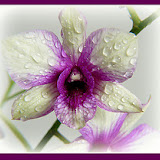 Next to the rose, orchids are the flowers most in demand in both the private and commercial marketplace. No plant family has as many different flowers as the orchid family. Orchids are known to grow in most every part of the world with the exception of
Next to the rose, orchids are the flowers most in demand in both the private and commercial marketplace. No plant family has as many different flowers as the orchid family. Orchids are known to grow in most every part of the world with the exception of
Most African orchids are white, while Asian orchids are generally multicolored. Some orchids grow only one flower on each stem, while others can have more than a hundred blooms on a single spike.
When not in bloom, orchids very much resemble wild grasses and or palms. They can be grouped according to the way they retrieve their nutrients. The majority of the species are found in tropical, moist broad leaf forests or mountains. These orchids anchor themselves onto other plants, mostly trees. However, they are not considered to be a parasite.
Then there are a few species that grow naturally on rocks or on very rocky soil. Both of these species gets their nutrients from the atmosphere. Such as rain water, litter, humus, and even from their own dead tissue. Orchids are also one of the most adaptable plant groups on earth. Some Australian orchids grow entirely underground.
Those orchids we plant in our gardens are known as terrestrial plants and are planted in the soil just like most any other flower. If your area isn't conducive to growing orchids, you can still grow them in a hothouse. Be patient, however. The seeds of an orchid are extremely tiny. Under natural circumstances, the seeds can only germinate with the use of a special fungi. It takes anywhere from one to ten years for an orchid seedling to mature.
The ideal place in the home for growing orchids is a bright window, free from drafts, where your plants receive indirect sunlight both morning and afternoon. (A south window is best.) In winter, give orchids all the light possible. the equivalent to a bright south-facing window. With extra large windows or especially intense sunlight, the light may be adjusted downward by moving plants 18 to 36 inches from the window. Plants in the home require a greater light intensity because they receive light from only one direction, while in a greenhouse they receive light from many sides.
One orchid genre is commercially important other than for the value of the flowers. The vanilla orchid is used as a flavoring, and indeed is the source of vanilla. The underground tubers of terrestrial orchids are ground to a powder and used for cooking. Interestingly enough, the Coca-Cola Company is the world's largest user of vanilla. Because vanilla is such a labor intensive crop due to having to hand-pollinate the flowers, it is most suited to small family farms.
The scent of orchids is frequently used by perfumists. With these exceptions, orchids have virtually no commercial value other than for the enjoyment of the flowers.
Both tropical and subtropical orchids are available at nurseries and through orchid clubs across the world. There are also quite a few orchids which grow in colder climates, although these may be more difficult to find. The
Orchids have now become a major market throughout the world. Buyers bid hundreds of dollars on new or improved hybrids. As mentioned earlier, they are now one of the most popular cut-flowers on the market. Though orchid hybridization has been happening for many years, only recently has new technology made it into what it is today.


